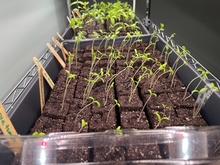Start with clean materials
One of the most common problems affecting seedlings is damping off. This problem is caused by a number of pathogens including Rhizoctonia spp., Fusarium spp., and Pythium spp. This condition typically results in seedlings collapsing at the base of the stem, and you can often see fungus growing where the stem meets the soil.
Seedlings infected by damping off rarely survive.
- To avoid damping off, clean all of your potting media (trays, pots, tools) thoroughly with soap and water.
- Follow with a sanitizer.
- Plant with clean hands.
- Use sterile potting media, such as a store-bought potting mix.
Make sure your seedlings have enough light
Your seedlings will quickly let you know whether they are receiving enough light. Plants tend to stretch towards light sources. If you notice that your seedlings are leaning towards a window or a lamp, they likely need more light.
In the process of reaching toward a light source, seedlings can develop weak stems, making them less healthy overall.
If you are not using artificial lighting, consider adding a light. If you have artificial lights already and your seedlings are still stretching, try moving them closer to the plants.
Make sure you water consistently
Certain seedling tray designs make it challenging to water plants consistently. Watering from the bottom (adding water to the bottom of the tray vs. pouring water over the top) is a great way to reduce the time you spend watering and to ensure more even watering. It can also help to prevent disease by keeping the foliage of your seedlings dry.
Certain tray and insert designs, such as trays with ridges separating each individual cell or inserts that fit snugly into the tray, can make it harder to water evenly. Keep an eye out for soil moisture inconsistencies, and adjust your planting system if you’re having issues.
Don’t overwater
Overwatering is a common issue when you’re new to starting seeds. If you have seedlings that are tipping over from the top, they may have a condition known as epinasty. When your soil is water-logged, it becomes hypoxic, or oxygen-deprived.
This condition can be a bit misleading because it can look like wilt, which may cause you to want to water even more. Many people think they need to water seedlings daily, but that’s often more water than your plants need. Especially when plants are small, their root systems are not yet developed, and they will not take up very much water.
Keep your soil moist, but try to avoid soaking it. As your plants’ root systems develop, they will take up more water each day. Your potting mixture will also determine how well water drains from your system.
Overwatering can also create soil conditions where small insects like fungus gnats thrive. Adapting your watering routine to avoid over-saturating your soil should help to minimize insect problems. Adding a fan to promote good ventilation should also help.
Dealing with hard water
“Hard” water refers to water with a high concentration of dissolved calcium and magnesium. Water that is considered “hard” is often associated with a high pH and high alkalinity. In an outdoor garden environment, the impacts of hard water often go unnoticed because they are balanced with acidic rainwater.
But in a small space like a seedling tray, where your tap water is the only water source for your growing plants, you may see an effect. Before you begin to notice plant health effects, you may notice a crust on the surface of the soil.
In this situation, consider watering with a different source of water, or at least supplementing your watering routine with a different water source. Many grocery stores have distilled water dispensers where you can fill your own containers.


